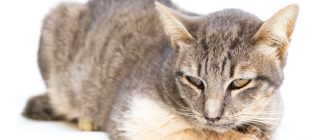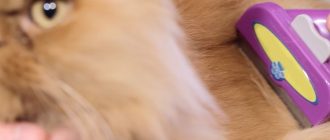Rhinotracheitis (herpes virus infection) – a disease, caused by the feline herpes virus that affects eyesight and airways of the animal. In the absence of proper treatment, the cat may die, especially if other rhinotracheitis is accompanied diseases and poor health of the animal. Infection occurs while the cat is communicating with sick individuals by airborne droplets and genital tracts, as well as in utero from mother to fetus (most often kittens do not survive or are born with defects). A healthy cat, after eating or drinking from an infected bowl, has a chance of getting sick. Even the owners themselves, without knowing it, can bring home a virus, for example, stroking a stray cat on the street. Especially cats with weakened cats are susceptible to this disease. the immune system, as well as young animals, those who live in unsanitary conditions, in drafts. If the cat is observed runny nose, watery eyes, she often sneezes, then perhaps it takes place to be rhinotracheitis – a disease in which a visit to a veterinarian help the animal gain health.
What happens with rhinotracheitis in cats
Contents
With this disease, necrosis of nasal epithelial cells occurs. cavities, nasopharynx, tonsils, trachea, lymph nodes, cornea. The incubation period for rhinotracheitis lasts about a week. Disease may have an acute or chronic course. Even after The treatment most often cat (in almost 70-80% of cases) remains the carrier of the virus in the absence of signs of the disease, therefore it is advisable to timely prevent the infection of other individuals (to vaccinate, do not give the opportunity to a sick cat mate and give birth). In the absence of treatment, a cat can often suffer from a concomitant disease in which the bacterial or another viral infection can affect the respiratory system and vision, which greatly complicates the condition of the animal and leads to complications, and sometimes fatal.
Symptoms of rhinotracheitis in cats
Depending on the acute or chronic course of the disease in animal, the symptoms of rhinotracheitis in cats may vary. Acute rhinotracheitis (lasts most often no more than 14 days) manifests itself in the form of fever, excessive salivation, sneezing, cough, discharge from the eyes and nose (mucous membranes, and sometimes purulent), lack of appetite, conjunctivitis, inflammation of the larynx, trachea, wheezing on breathing, tongue ulcers. Chronic rhinotracheitis can “sleep” in a cat’s body for a long time when the animal doesn’t has such obvious symptoms as in acute form and discovers yourself in connection with the experienced stress or any disease. At chronic form observed: central nervous system disorders system and motor apparatus, pneumonia, keratitis (inflammation cornea of the eyes), blindness (occurring after the appearance of ulcers on shells of the eye). The acute form of rhinotracheitis can go into chronic, if medication is not prescribed and performed treatment. In any case, the symptoms of the disease are visible to the owner. with the naked eye, so the animal has every chance of being cured. This disease can also threaten the cat. dehydration, since it’s hard not only to swallow food, but also water. An experienced veterinarian will have no problem recognizing herpesvirus infection in a cat, even visually, but usually An enzyme-linked immunosorbent assay or method will be offered to the cat owner polydimensional chain reaction to detect viral antigen and make an accurate diagnosis.
Treatment of rhinotracheitis in cats
Treatment of herpesvirus in cats involves the use of broad-spectrum antibiotics, antimicrobial sulfonamides, immunomodulators and vitamins. Depending on the health conditions and symptoms, your doctor may prescribe antipyretic (if temperature is present) and antihistamines funds (when there is swelling of the mucous membranes). However, if the temperature of the cat does not exceed 39 degrees, some doctors do not recommend lowering it medications due to intolerance to the herpes virus of cats high temperatures. Cat’s eyes and nose should also be treated. special ointments, drops as prescribed by the doctor. Treatment time is from 7 to 14 days. During treatment, the animal must stay in a warm room without drafts, while the rest cats should be isolated for a while. Nutrition for the treatment period is choose room temperature, liquid, grated: beef and chicken broths and mashed potatoes with vegetables, cereals, baby meat puree. The owner should treat as much as possible all surfaces, with with which the infected cat could touch, as well as her accessories: tray, bowls, stove benches, etc.
Disease prevention
Annual vaccination (in kittens from 8 months old) is the most the main measure of prevention of rhinotracheitis in cats. Owner should take care to contact the animal with other individuals whose health in question has been minimized. Accommodations cats, the cleanliness of her sleeping place and accessories also has important place. Show your cat to a veterinarian in a timely manner, monitor the quality and freshness of its feed, solder with vitamins in spring and autumn, because the strong and active cats disease touches last.






